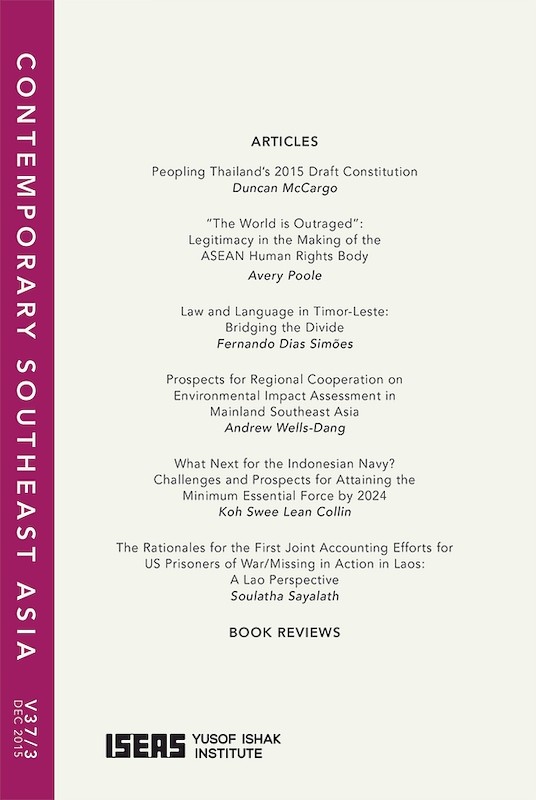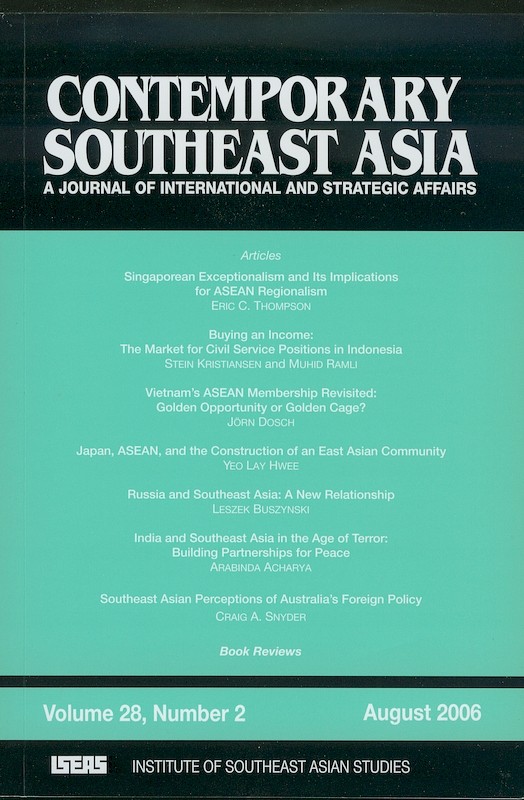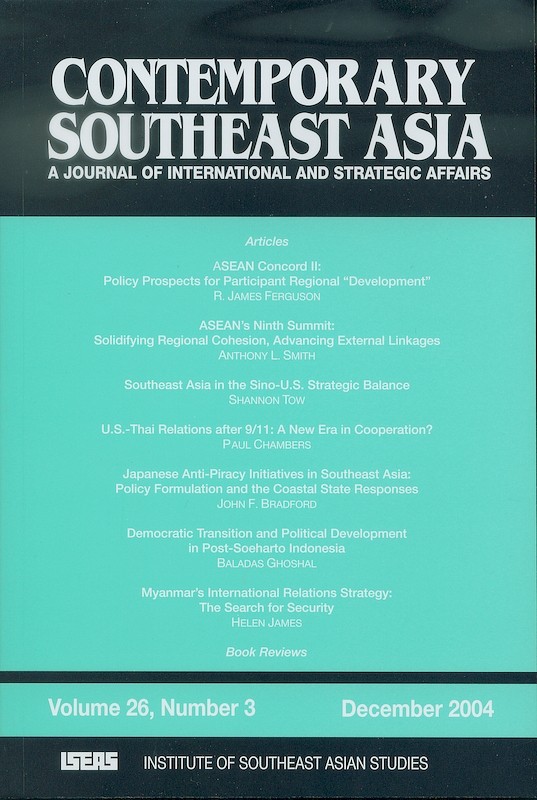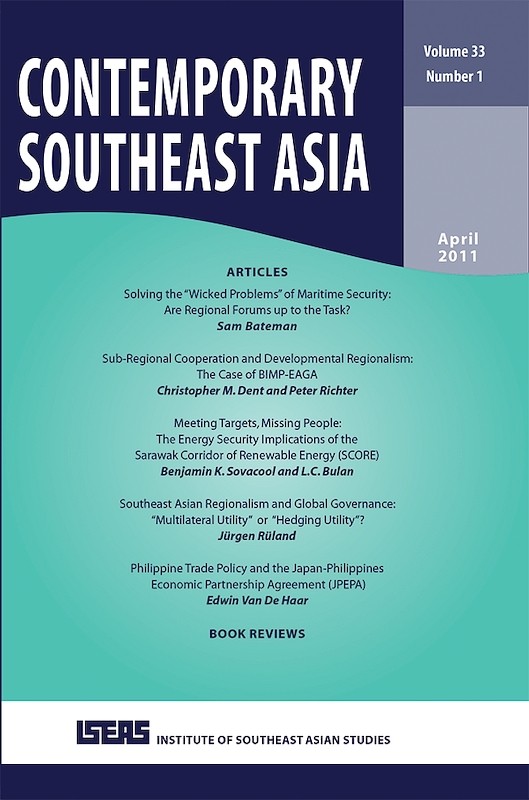Contemporary Southeast Asia Vol. 30/2 (Aug 2008)

Date of publication:
August 2008
Number of pages:
192
Code:
CS30/2
Contents
-
Contemporary Southeast Asia Vol. 30/2 (Aug 2008)
[Whole Publication] -
Preliminary pages
- ARTICLES
-
The Essence of Hedging: Malaysia and Singapore's Response to a Rising China, by Kuik Cheng-Chwee, author see abstractRecent International Relations scholarships and policy publications have used the term hedging as an alternative to "balancing" and "bandwagoning" in describing small states' strategies towards a rising power. In the case of Southeast Asian countries responses to a re-emerging China, more and more analysts have asserted that none of the smaller states are pursuing balancing or bandwagoning in the strict sense of the terms, and that the states are in fact adopting a "middle" position that is best described as "hedging". This paper seeks to assess this assertion by performing three principal tasks. First, it attempts to identify the key defining attributes and functions of hedging as a strategy that is distinguishable from pure forms of balancing and bandwagoning. Second, it aims to operationalize the term within the context of Southeast Asia-China relations, by focusing on the cases of Malaysia and Singapore's response to China in the post-Cold War era. Third and finally, the study explains why these two states have chosen to hedge in the way they do. The central argument of the essay is that the substance of the two smaller states' policies are not determined by their concerns over the growth of China's relative power per se; rather, it is a function of regime legitimation through which the ruling elite seek to capitalize on the dynamics of the rising power for the ultimate goal of justifying their own political authority at home.
-
Thailand's Intractable Southern War: Policy, Insurgency and Discourse, by Marc Askew, author see abstractWith the complex crisis in Thailand's Muslim-majority border provinces now in its 5th year and a grim legacy of over 3,000 deaths, opinion is divided over the prospects of substantial improvement, though the authorities claim that headway is being made. This article offers a critical review of policy, key events and discourses surrounding the crisis in the south from the coup of September 2006 to the first months of the new civilian government under Prime Minister Samak. It argues that the southern situation remains intractable for a number of key discursive/political and military/operational reasons, including: the difficulty of combating a war against clandestine, cell-based insurgent groups that employ propaganda as much as violence and show no desire to negotiate; a politics of denial among single-issue groups who continue to avoid confronting the full realities of insurgent violence while condemning state officials as principal aggressors; and the difficulties confronted by authorities in pursuing a dual policy of law-enforcement and "peaceful development" in the face of incomplete intelligence and suspicious villagers. It is unlikely that the lessening of violence will be any more than incremental in the foreseeable future, or that the meaning, causes and solutions to the "fire in the south" will be any less contested.
-
Islamist Realignments and the Rebranding of the Muslim Youth Movement of Malaysia, by Ahmad Fauzi Abdul Hamid, author see abstractThis paper traces changing patterns of Islamism in Malaysia, focusing on developments during Dr Mahathir Mohamads final administration (1999-2003) and since Abdullah Ahmad Badawi assumed the premiership of the country on 31 October 2003. This period witnessed the making of a nascent Islamist civil society whose alliances have capriciously undergone realignments and reconfigurations in its endeavour to reach a stable equilibrium with non-Islamist forces. The emergence of a vibrant and burgeoning civil society in Malaysia has been characterized by lively vicissitudes in the relationship between its Islamist and non-Islamist elements. Having experienced a colourful and chequered relationship with the state and other Islamic movements since its official founding in 1971, the Muslim Youth Movement of Malaysia (ABIM: Angkatan Belia Islam Malaysia) has, since its leadership rejuvenation in 2005, attempted to reassert its dominant place as an influential and legitimate voice of the Malay-Muslim masses, but with mixed ramifications.
-
Governing Singapore's Security Sector: Problems, Prospects and Paradox, by See Seng Tan, Alvin Chew, authors see abstractFor the most part, the theory of security sector governance does not comport with extant Southeast Asian realities owing to its Western assumptions and expectations. Singapore's security sector resembles that of other ASEAN countries in its technocratic, illiberal and comprehensive security-oriented aspects, where governance is exercised solely in a top-down fashion ("governance by national government"). Against this common wisdom, we argue that the Singapore case can, with qualifications, also be understood in terms of both "governance with multiple governments" and "governance without government", categories that better fit Western industrial democracies. For example, growing regionalism in Southeast Asia suggests, not inconceivably, that the future management of the region's security sectors, not least Singapore's, could be a multi-tiered, shared enterprise involving not only national governments, but regional organizations such as ASEAN as well as non-official mechanisms ("governance with multiple governments"). Moreover, the highly professionalized fashion in which Singapore manages its security sector differs markedly from the "new/developmental professionalism" of other ASEAN security sectors. Borrowing from Michel Foucault's ideas of disciplinary intervention and self-formation, we show how Singapore's security is in part reliant on habits and rituals of self-governance among ordinary Singaporeans ("governance without government").
-
ASEAN and Multilateralism: The Long, Bumpy Road to Community, by Sheldon W Simon, author see abstractOf the three Asian subregions -- Northeast, Southeast and South -- Southeast Asia is the only one that contains no Great Power. Yet Southeast Asian states have originated most Asian regional organizations, and Southeast Asian procedures acquired through ASEAN determine their processes. The "ASEAN Way", emphasizing consensus, non-interference in members' internal affairs and voluntary enforcement of regional decisions have characterized these bodies, insuring at bottom that they reinforce sovereignty protection. Nevertheless, ASEAN's expansion in the 1990s to include Vietnam, Laos, Myanmar and Cambodia incorporated states whose harsh domestic politics were seen by several of the Associations original members to be undermining its international stature. Additionally, coping with terrorism in the new century has also led to some erosion of the non-interference norm. Transnational cooperation is now essential to each nation's security because terrorist groups cross national borders, and egregious human rights practices in one country can lead to refugees fleeing into neighbouring countries. ASEAN's new November 2007 Charter constitutes an effort to move beyond sovereignty protection to economic, political-security and socio-cultural communities by 2020. The Charter also commits its signatories to democracy (for the first time) and human rights. Other regional organizations dominated by ASEAN procedures include the ASEAN Regional Forum (ARF) for security discussions, ASEAN+3 (Japan, South Korea and China) for economic matters, and the East Asia Summit (EAS) which added Australia, New Zealand and India to the ASEAN+3. Dialogues in these groups cover the gamut of Asian international relations. Perhaps their greatest utility is as venues for national leaders to discuss pressing issues on the sidelines of these gatherings.
-
The United States and the East Asia Summit: Finding the Proper Home, by Malcolm Cook, author see abstractThe East Asia Summit is the newest leaders-led regional organization in the Asia Pacific with a broad mandate and an unclear future. Its membership means that it is stuck halfway between being an East Asian regional body such as the ASEAN+3 process and an Asia-Pacific body such as Asia-Pacific Economic Cooperation. Expanding the East Asia Summit to include the United States would enhance its ability to be the primary strategic forum in Asia and clearly identify the Summit as an Asia-Pacific body. This would not only improve Asia's regional architecture, but would also serve the interests of the United States, ASEAN, Japan, China and India. The biggest challenge facing this positive development is convincing the United States to sign the Treaty of Amity and Cooperation and overcoming the concerns of the other regional bodies about an enhanced East Asia Summit. In 2009, a new administration in Washington and the EAS meeting in Vietnam will provide a powerfully symbolic opportunity to invite the United States into the East Asia Summit and allow the Summit and the United States to find their proper homes in Asia's evolving regionalism.
-
A People-Oriented ASEAN: A Door Ajar or Closed for Civil Society Organizations?, by Alan Collins, author see abstractASEAN has proclaimed the rhetoric of becoming "people-oriented" in a number of documents over recent years and this phrase also appears in the Association's new Charter. The prospect that ASEAN is moving away from being state-centric and elite-driven to one that is "people-empowering" has brought ASEAN onto the radar screens of civil society organizations (CSOs). These CSOs, encouraged by ASEAN reaching out to engage with them in its Socio-Cultural Community Plan of Action, have responded enthusiastically to this rhetoric and since 2005 there have been a plethora of ASEAN civil society conferences. Despite this the ASEAN Charter has not been well received by CSOs; indeed they are aiming to adopt an alternative (an ASEAN Peoples' Charter). This article examines why CSOs are disappointed with the Charter and what ASEAN means by "people-oriented".
- BOOK REVIEWS
-
BOOK REVIEW: Sukarno and the Indonesian Coup: The Untold Story. By Helen-Louise Hunter., by Robert Cribb, author
-
BOOK REVIEW: Malaysia: Fifty Years of Diplomacy. By Chandran Jeshurun., by Johan Saravanamuttu, author
-
BOOK REVIEW: Securing Southeast Asia: The Politics of Security Sector Reform. By Mark Beeson and Alex J. Bellamy., by Dzirhan Mahadzir, author
-
BOOK REVIEW: East Timor: Beyond Independence. Edited by Damien Kingsbury and Michael Leach., by Anthony L Smith, author
-
BOOK REVIEW: Globalization, Culture and Society in Laos. By Boike Rehbein., by Vatthana Pholsena , author
-
BOOK REVIEW: The Terrorism Ahead: Confronting Transnational Violence in the Twenty-First Century. By Paul J. Smith., by Shyam Tekwani, author





